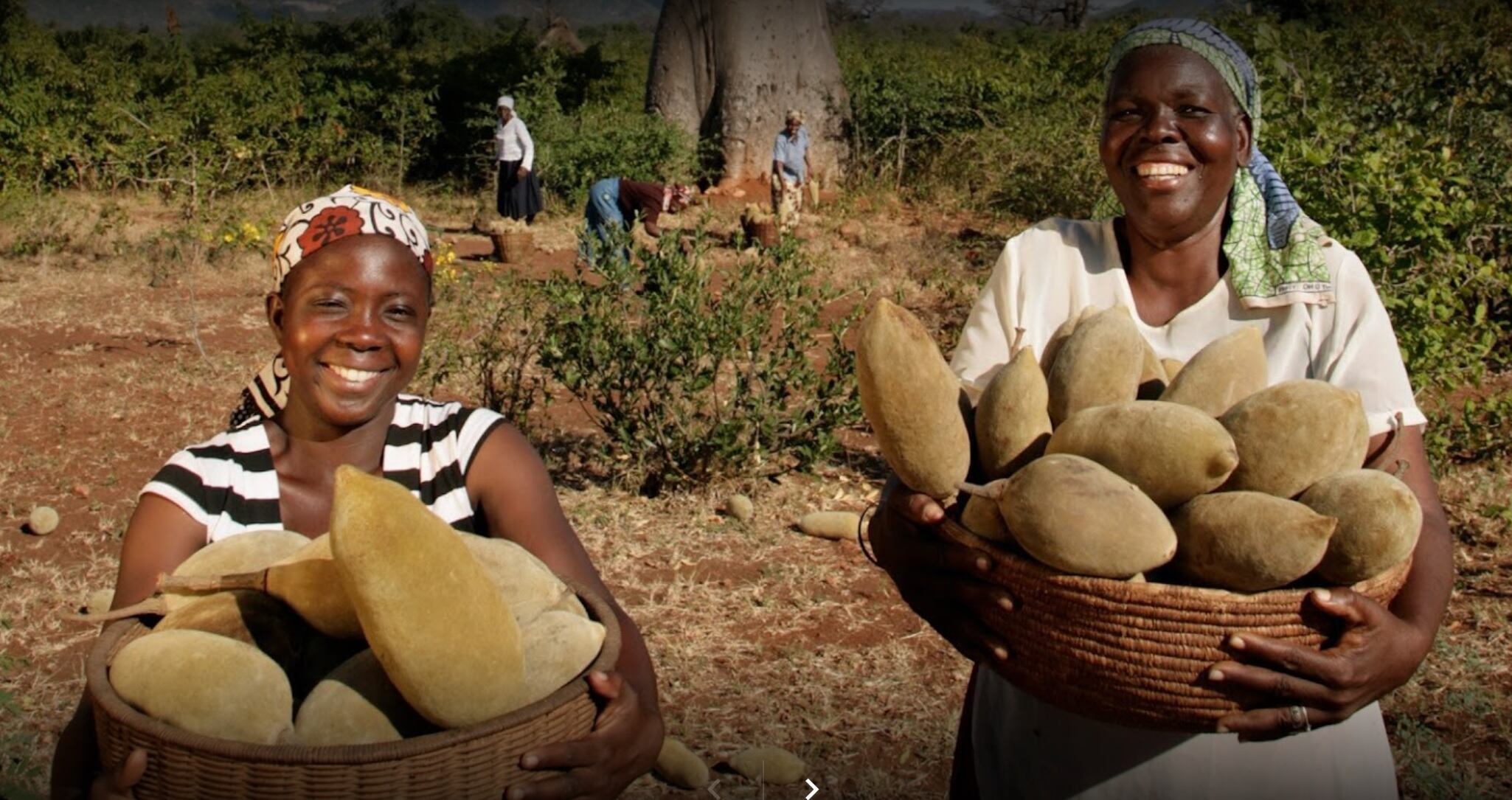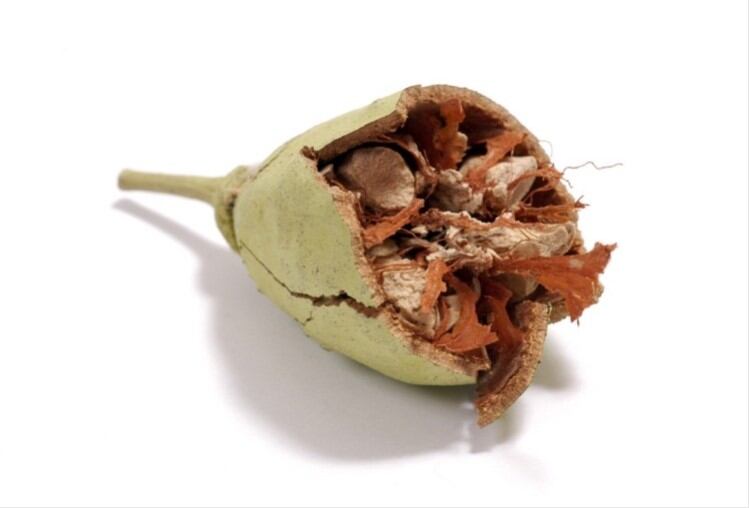Baobab is the fruit of the Adansonia digitata tree, which grows primarily in South Africa, Botswana, Namibia, Mozambique and Zimbabwe, where the climate is arid. The plant, which is classified as a succulent, is a symbol of life in a landscape where very few plants can thrive. Because it produces nutrient-dense fruit in the dry season when all around is withered, it is known as "The Tree of Life" and an icon of the African continent.

Baobab fruit have a hard coconut-like shell that can be cracked to expose a chalky flesh around large, fat-rich seeds. The fruit pulp is rich in antioxidants, riboflavin, niacin, pectin and citric, malic and succinic acids, while the oil also contains the vitamins A, D and E. The high levels of vitamin C in the fruit provide a citrus flavor. The pulp also has prebiotic properties and stimulates the intestinal microflora.
There has been some research on the benefits of baobab, such as its positive impact on digestion and blood sugar levels. It also has demonstrated effects on satiety, according to this study and with the baobab as a staple of their diets, the Hadza tribe of Tanzania are hunter-gatherers known to have a high diversity of gut microbes. Most recently, a 2022 study published in Nutrients noted baobab as a "promising source of natural antioxidants and a hypoglycemic agent under glucose load acute conditions."
Compound Solutions, Inc. recently launched its new ingredient Fibriss organic, a 3-in-1 baobab fiber. According to the company, it is wild-harvested, sustainable and has a transparent supply chain and offers opportunity to the women in the African communities where it’s harvested.
“We see this incredible ingredient adding gut health benefits to some of today’s most popular categories including collagens, greens and reds, meal replacements, proteins and vegan proteins, and fiber products of course. CSI philosophically believes that gut health is human health, therefore a powerful fiber containing soluble, insoluble fiber as well as polyphenols can certainly help transform human health,” said Matt Titlow, CEO of Compound Solutions.
Fiber: the next protein?
Just 5% of the US population meet the Institute of Medicine’s recommended daily fiber target of 25 grams for women and 38 grams for men. This population-wide deficiency is what nutritionists call the “fiber gap.”
“Ninety-five percent of Americans don’t get enough fiber, yet fiber is the foundation of all human health. While there is nearly zero protein deficiency in the USA, fiber deficiency is a crisis individually and for our healthcare system,” said Titlow. “Fiber is the next protein.”
How Baobab stacks up to psyllium husk
“Fibriss has a mild citrus flavor, mixes instantly and stays drinkable indefinitely. On the other hand, psyllium husk has a mild earthy flavor, mixes well, but becomes an undrinkable gel if not consumed within one minute. Psyllium husk contains soluble fiber, whereas Fibriss contains soluble and insoluble fiber, as well as polyphenols and naturally occurring vitamins and minerals. Fibriss is organic; psyllium husk is only sometimes organic. Fibriss is wild-harvested and sustainable; psyllium husk is cultivated and largely sustainable. Fibriss is allergen-free and doesn’t have the GI problems individuals and formulators face with inulin, for example. Whether it’s psyllium husk, acacia fiber, resistant potato starch or polyphenols, it’s great to formulate a ‘fiber rainbow’ in products. If we should “eat the rainbow,” then we should formulate for it as well. So, the next generation of fiber, greens, reds, collagen and meal replacements will contain combinations of traditional fibers, resistant starches and Fibriss,” Titlow said.
Homegrown solutions
Titlow told NutraIngredients-USA that one reason reason for the slow market penetration is supply chain transparency and sustainability.
“We’ve partnered with Baobab Foods to ensure a secure and transparent supply chain upheld by quality and safety certifications including Ecocert in South Africa, EcoCert and BCS in the US and EU, and FSSC 22000 for the manufacturing facility. Baobab Foods’ ESG credentials are unmatched, as well. Fibriss baobab fiber is sustainable and harvested by communities of women who do not otherwise have an opportunity to generate an income. Fibriss and Baobab Foods are having a direct and positive impact on these communities,” explained Titlow.
The baobab is an ancient species that predates the splitting of the continents over 200 million years ago. With the trees taking as long as 15 to 20 years to fruit, they are wild grown.
“Baobab trees are hundreds of years old and are a part of Africa’s natural landscape. Baobab Foods travels to remote destinations throughout the continent to partner with communities of harvesters. The fruit is gathered after it has fallen from the trees, and these communities are the stewards of this beautiful Tree of Life. Baobab Food’s long-term relationships with harvesters has allowed this incredible fiber to become available to formulators and consumers everywhere,” Titlow said.
Marketing faux pas
According to Marketwatch, the global Baobab market was valued at $2396 million in 2020 and it is expected to reach $3551.9 million by the end of 2027, growing at a CAGR of 5.3% during 2021-2027.
Titlow explained the main reason baobab has been slow to gain traction is because it’s being marketed as a sexy superfruit rather than dietary fiber.
“Africans aren’t eating a trendy ‘superfruit’—They’re eating a super, whole-food FIBER also rich in vitamins and minerals. Fibriss organic baobab fiber isn’t a trend; it’s the start of what will be decades of research and formulation that will surpass the value of protein to human health.”


